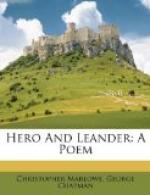|
This section contains 6,838 words (approx. 23 pages at 300 words per page) |

|
SOURCE: Segal, Erich. “Hero and Leander: Góngora and Marlowe.” Comparative Literature 15, no. 4 (fall 1963): 338-56.
In the following essay, Segal contrasts Marlowe's and Luis de Góngora y Argote's versions of the Hero and Leander story.
That contemporaries like Góngora and Marlowe should have chosen the same classical myth is hardly a remarkable literary phenomenon.1 What is interesting about their versions of the Hero and Leander story is that, while their approaches are similar, they stand diametrically opposed to all previous treatments of the legend. Both poets have made mock heroic a tale hitherto treated only with high seriousness, casting an unsentimental eye on what was traditionally the tenderest of love stories. In their cynical interpretations, Marlowe and Góngora employ similar images, make similar mythological allusions, and describe their protagonists in similar artificial terms. Yet these two comic epyllia, independently conceived though remarkably akin in spirit...
|
This section contains 6,838 words (approx. 23 pages at 300 words per page) |

|


